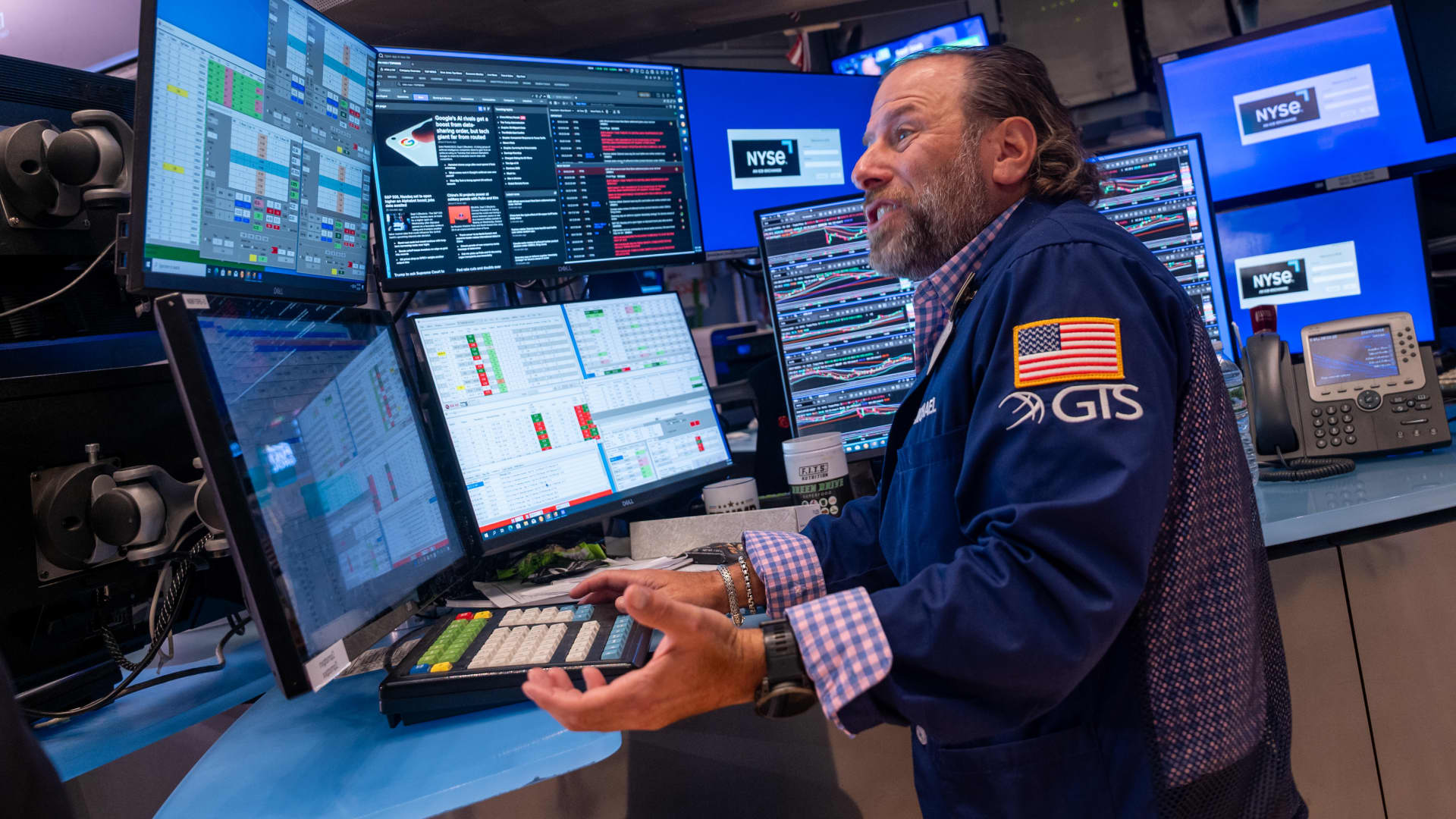Bear-baiting is illegal in a majority of states that allow bear-hunting, but on Wall Street it’s happening right out in the open. The markets have dangled in front of the bear den a weaker-than-hoped jobs report Friday, which took its three-month average payroll gain to minimal levels mostly seen ahead of recessions. Nvidia , the biggest stock in the universe and the principal vehicle of this bull market’s most propulsive theme, has fallen 8% and cracked below its 50-day average in seven trading days since posting a stellar quarter. Bitcoin has traced out a similar pullback pattern in breaching the same trend line, falling 10% from its August peak. The most-coveted initial public offerings of recent months have been wretched since their Roman-candle rallies upon first listing: Figma , Circle , CoreWeave , Chime Financial and Bullish are all between 40-60% beneath their immediate post-pop peak. Let’s not forget that all of these ailments and injuries to the tape have struck in what is solidly the worst month historically for stock returns and against a backdrop of generous equity valuations. This daunting, if admittedly selective, litany of ills has merely slowed the bull market moderately, prompting some fortuitous rotation from previous leaders to 2025 laggards, leaving the S & P 500 up 10% for the year and less than 1% and one day removed from an all-time high. Friday’s action — a modest S & P decline after a downside reversal from an initial post-payrolls pop – is a bit of a microcosm of the market’s mode since midsummer. The sizable shortfall in August job growth – just 22,000, a third of the forecast number – galvanized an already solid market expectation of a Federal Reserve rate cut the week after next. But a somewhat firmer jobs print would have done the same, and the report triggered a ferocious rally in Treasuries and downside reversal in bank and consumer-cyclical stocks that reflected wavering confidence that this rate cut would be happening in a resilient economy. Before long, though, traders executed the silver linings playbook, bidding up rate-sensitive housing stocks, goosing the small-cap Russell 2000 and embracing a powerful rally in Broadcom shares after a blowout profit report and outlook, allowing another pass of the AI heavyweight mantle of leadership to new names. This week it was Broadcom, Alphabet and Apple over Nvidia and Microsoft . (Over the past two years, Broadcom’s stock appreciation has now outpaced Nvidia’s, 283% to 244%. Together, they make up 10% of the S & P 500. For the sake of the nation’s retirees-to-be, this AI silicon revolution had better last a while.) How desperately does economy need Fed’s help? On the macro front, there’s no doubt that the jobs report turned up the level of concern about the economy’s growth pace by a few clicks, while putting some pressure on the not-insignificant camp of economic handicappers who have been calling for an incipient reacceleration in U.S. growth. Bank of America economists – part of that camp – on Friday backed away from their prediction of no rate cuts this year, penciling in two cuts, due both to the jobs data and Fed Chair Jerome Powell’s expressed “reaction function” emphasizing downside risks to employment over sticky and tariff-influenced inflation. It also helps that there are asterisks and extenuating circumstances around the labor data this year. No, not the accuracy of the numbers themselves, but the pronounced drop in foreign-born workers and ongoing aging of the population that are depressing the total labor pool. Estimates of the minimal monthly payroll gain needed to hold the unemployment rate steady are down a lot, perhaps below 50,000. So, it’s been possible to be reasonably upbeat about the GDP pace thanks to capex, a resilient services economy, ample Federal deficits and wealth-effect spending by high earners, while not expecting much from job gains. Even within the jobs report, some found reassurance, pointing to an uptick in prime-age workers employed. As a general matter, it’s hard for incremental evidence to dislodge an entrenched macro narrative that’s been affirmed by market action itself. Such is the case currently, with the notion that the Fed can cut rates without the economy desperately needing the help, with stocks at a record, credit spreads tight and layoffs running at a relative trickle. And will lower short-term rates help? For stocks, the sample size is small, but in the past when the Fed has resumed rate cuts after a pause of at least six months, the forward performance was quite good. As for the real economy, a case can be made there’s room for some relief. Ned Davis Research constructed a Main Street Financial Conditions Index, using real home prices, consumer-loan availability and other metrics, which here is shown to be dramatically tighter than public-financial-market gauges. If Powell is shown not to be “too late” in making policy rates less restrictive, then the recent tumble in Treasury yields and reduction in mortgage rates, along with a fresh supply-driven breakdown in crude-oil prices, should fluff the cushion beneath consumers. Tariffs are a regressive and haphazard tax on consumers, businesses and global efficiency, and their full effect hasn’t yet shown through, but that doesn’t mean they’re damaging enough to derail the economy. Valuation concerns These hopeful sentiments help explain why the market has held in as well as it has rather than arguing for a blast higher from here. On the whole, truly extreme optimism or aggressive positioning are not among this market’s issues, though investor equity allocations are full and the dip-buying impulse remains strong. Sell-side strategists’ index targets collectively are quite conservative, the average and median year-end bogey right around current index levels. It’s true, as so many are quick to remind us these days, that equity valuation is a poor timing tool, particularly when earnings are growing and the Fed in easing mode. No denying this reality, but it sets a higher bar for longer-term returns. And is it pure coincidence that the S & P 500 forward P/E during this near-three-year bull market has stalled a handful of times upon reaching current levels around 22.5 and that the Nasdaq 100 P/E has bumped its head on an apparent ceiling at 28? Or is this just more bait set out for frustrated, hapless bears?





